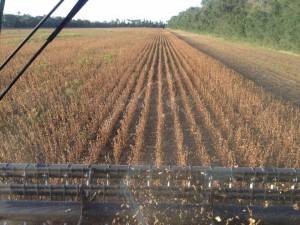
Harvesting soybeans on a timely basis should be every farmer’s goal. Yields are maximized when each field is harvested at 13% moisture and combines are adjusted properly from the start. That being said, I’ve been asked numerous times just what the yield loss is when moisture falls below 13% and how to prevent soybeans from “shattering.”
Let’s tackle the first part of the question right away: “What is my yield loss when soybeans come in below 13%?” A recent article published by Gary Zoubek and Chuck Burr from the University of Nebraska Extension states the following:
|
Moisture at Harvest |
% Yield Lost |
|
12% |
1.14 |
|
11% |
2.25 |
|
10% |
3.30 |
|
9% |
4.40 |
|
8% |
5.43 |
Using this information, a field yielding 75 bushels per acre harvested at 9% results in 3.3 fewer bushels per acre than if it would have been harvested at 13%. You will lose $33 per acre if the soybean market is at $10 per bushel!
Because life isn’t always perfect and we sometimes are prohibited from harvesting exactly at 13% moisture, here are a few simple suggestions that can help you put more in the hopper:
- Begin harvesting soybeans at 14% or even 15% moisture, depending on your plans for the grain. If you are taking it directly to the elevator at harvest, ask the maximum moisture they will accept. If you are storing the grain in a bin, make certain you have fans for adequate ventilation/drying.
- When harvesting at higher moistures, you will most likely run into tougher or even green stems. Adjust your combine and operate at reduced speeds to match the conditions of your field. NOTE: You’ll probably need to adjust your combine and your speed several days each day!
- When possible, harvest under optimum conditions. We all know that soybeans pick up moisture overnight, especially if there is a heavy dew. They also lose moisture as the day progresses, when the humidity is low, when daytime temperatures are warm and when there is even a slight breeze. Avoid harvesting during hot afternoons when you stand to lose the most moisture.
Another tip for harvesting soybeans on a timely basis is to spread out the maturities. Keep this in mind now as when selecting your soybean seed for next year. Don’t place “all of your eggs in one basket” when it comes to selecting the maturity of soybean seed.
Moving on to the second part of the question stated in the first paragraph: “How can I keep soybeans from shattering?” “Shattering” implies that something is wrong or abnormal. However, I truly believe it’s natural for a pod to split open and soybeans fall to the ground because these plants were created to spread their seeds and propagate! To prevent “shattering,” spread out your maturities so you may harvest your soybeans in a timely manner.
Wishing you a safe and productive harvest!
